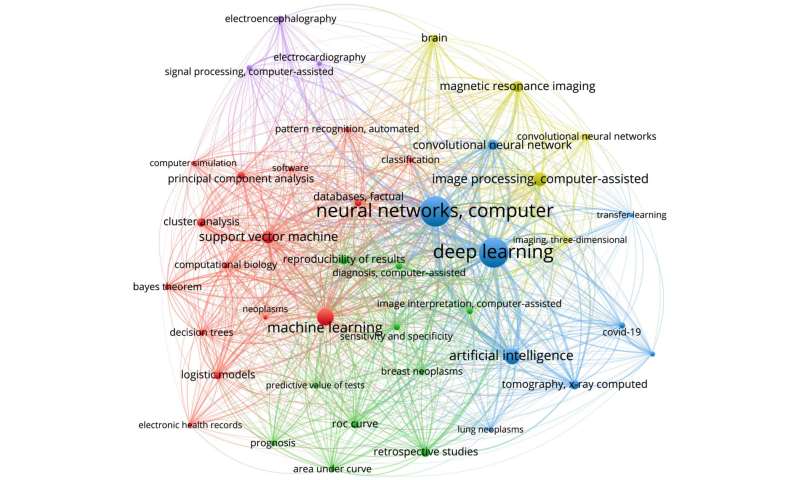Doctors are opting for simpler AI algorithms

Scientists from BFU have determined that medical professionals favor using simpler machine learning algorithms rather than deep learning AI. It is due to the fact that artificial intelligence leaves no opportunity for the specialists to interpret the results, whereas a final opinion has to be given by a doctor in order to avoid any mistakes. Furthermore, the authors have determined which exact AI algorithms are used in separate medical fields. As a result, this article may serve as a reference manual to help medical staff choose the optimum machine learning method for a specific task. The research results have been published in the International Journal of Environmental Research and Public Health.
AI technologies are currently widely used in medicine. They help doctors detect abnormalities on photos, for example tumors, select individuals treatment for each patient and monitor the patient's condition in real time. Besides that, AI is used in robotic medical device development such as wearable sensors that take various measurements and send the data back to the doctor.
Scientists from Immanuel Kant Baltic Federal University (Kaliningrad) with their colleagues from National Medical and Surgical Center named after N.I. Pirogov (Moscow) and Russian Research Institute of Health (Moscow) have determined which AI algorithms are most popular in medicine, having analyzed their mention in 10 thousand research articles from PubMed database.
The authors have suggested an approach that allows to recover various structures of data-sets by creating networks of co-occurrence. With a program called VOSviewer, scientists have visualized a network that reflects co-occurrence of medical terms and concepts regarding AI algorithms. As key concepts, the scientists used such words and collocations as "artificial intelligence", "machine learning", "deep learning", "brain", "forecasting", "tomography" and other. It turned out that all terms can be categorized into five topic clusters.
The signal-processing cluster included concepts related to Electroencephalography (EEG) and electrocardiography (ECG), where AI is commonly used. Machine and deep learning clusters combined various AI system operating principles and approaches. At the same time, deep learning can be regarded as a form of machine learning, the main feature of which is that it's used in AI. It's not used in regular machine learning, and corresponding systems work on simpler mathematical algorithms.
The image-processing cluster combined algorithms used to analyze medical images and relevant areas, for example magnetic resonance imaging. The final cluster of retrospective studies was devoted to concepts related to assessment of reality and reproducibility of results.
The machine learning cluster, which is the biggest, had a vast amount of connections with the other sets of terms. Consequentially, the most frequent connections were with deep learning, image-processing and retrospective studies clusters. On the one part, these connections indicate that such algorithms are commonly used for analyzing medical images, in particular, neurological images. On the other, it indicates that it's used for for disease forecasting, for example tumor growth.
Research has also shown that deep learning, that is, AI, is rarely exercised in medicine, and if used, AI helps analyze images. This is due to the fact that decisions taken by such medical AI is difficult to explain in an explicit way. In other words, turning to the "black box" analogy, medical AI technology has to be transparent: whilst using, the doctor must be able to recover why the algorithm reached such and such conclusions. Whereas deep learning technologies often leave the doctors no room for interpretation of results obtained through them. At the same authors have determined that the methods based on deep learning are popular in cardiovascular system disease researches. Simpler, but a more easily interpretable machine learning algorithms are most often used for signal analysis, EEG and ECG for example, and prediction of disease development.
Besides that, the authors have determined that "visualization" and "health parameters" were the most common words in conjunction with AI terms in medical articles. This indicates that these technologies are primarily used for image processing and analysis of human condition based on his/her different body characteristics.
"Our findings may help health professionals choose optimum AI algorithms for their research activity. In this way, our article may serve as a reference guide both to doctors and IT specialists working in the medical AI field. We also believe that our proposed method may be effective in complex data analysis in other scientific fields. As developers of clinical decision support systems in the medical sphere, in the future we are planning on using the data we received to expand the range of the machine learning algorithms that we use in diagnosing brain diseases,"—says Alexander Hramov, doctor of Physics and Mathematics, professor, Chief Scientist Officer at Baltic Center for Neurotechnology and Artificial Intelligence of Immanuel Kant Baltic University.
More information:
Oleg E. Karpov et al, Analysis of Publication Activity and Research Trends in the Field of AI Medical Applications: Network Approach, International Journal of Environmental Research and Public Health (2023). DOI: 10.3390/ijerph20075335
Provided by Immanuel Kant Baltic Federal University